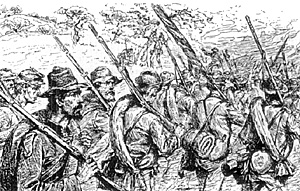 The morning and early afternoon was spent deploying the various Southern commands and waiting for Longstreet. Little was expected from Holmes other than holding Sykes and Morell in place. Confederate hopes that Longstreet's wing would not fight alone again were centered on Huger and D. H. Hill, at Hass Creek and Brackett's Ford respectively. How much help Jackson would provide by way of "Hampton's Ford" remained to be seen.
The morning and early afternoon was spent deploying the various Southern commands and waiting for Longstreet. Little was expected from Holmes other than holding Sykes and Morell in place. Confederate hopes that Longstreet's wing would not fight alone again were centered on Huger and D. H. Hill, at Hass Creek and Brackett's Ford respectively. How much help Jackson would provide by way of "Hampton's Ford" remained to be seen.
The forming gray battle lines and unlimbering batteries at Hass Creek and Brackett's Ford appeared ominous to Union scouts. All morning long Sumner and Richardson rolled for initiative. Despite the fact that both of these leaders are 4 rated, brigades from Richardson and Sedgwick didn't start moving to support Slocum until noon. The absence of a commanding general was felt already! Longstreet ordered the signal to be given at 1:30 p.m. The guns roared and the game was afoot. To make the story of a long battle short, the North had enough men to prevent any flank being seriously threatened. The constricted avenues of approach limited attempts to turn the Yankee line. Attacking right into the teeth of the Federal artillery, which seemed to be everywhere, was murder.
Good positions for the Confederate batteries were few. The losses on previous days left the Southern brigades with the best ground very brittle and with little offensive staying power. Even including the "Hampton's" Ford option, the terrain on Jackson's front is still such a hindrance that offensive movement is greatly restricted. The movement point cost of the wooded swamp hexes (6 for leaders) really limits command range. Even if the Rebel high command makes no mistakes, it will not be enough. The war will go on. The South can achieve a very great victory here, but any hope of destroying the invaders was left behind with the 10,000 casualties at Mechanicsville, Gaines Mill and Savage's Station. Utterly crushing "those people" will require the Army of Northern Virginia to operate at an extremely high level for the entire campaign, not just one battle.
Douglas Southall Freeman wrote that "Frayser's Farm was one of the great lost opportunities in Confederate military history. It was the bitterest disappointment Lee had ever sustained, and one that he could not conceal." Lee himself, a model of restraint, stated in his report that if all of the commands had cooperated, "the result would have proved most disastrous to the enemy." Two years of campaigning would never again produce an opportunity for a Cannae. Freeman's book has a photo of the poorly drawn map of the Richmond countryside that Lee had to rely on. No wonder his troops often failed to be in the right place! History would have been different if he had possessed the fabulous maps we are privileged to play our games on. This naturally leads to a variant that can transform any single battle or the entire campaign: As McClellan is slowly moving up the Peninsula, the Confederate government commissions Jedediah Hotchkiss to make a precise map of the area east of Richmond in anticipation that it will become a focal point of the campaign. It is incredible that this wasn't done! The map Hotchkiss made of the Shenandoah Valley played no small part in Jackson's brilliant movements and victories there. Again I want to thank The Gamers for such a high quality product. The Seven Days series is magnificent.
I'll give the last word to Edward Porter Alexander, from the less personal of his two journals: Military Memoirs of a Confederate, "No one day of the whole four years would seem to him (Lee) more unfortunate than June 30, 1862. It was, undoubtedly, the opportunity of his life, for the Confederacy was then in its prime, with more men available than ever before or after. And at no other period would the moral or the physical effect of a victory have been so great as upon this occasion."
More Glendale: South's Best Chance to Win the War?
Back to Table of Contents -- Operations #34
Back to Operations List of Issues
Back to MagWeb Master List of Magazines
© Copyright 1999 by The Gamers.
This article appears in MagWeb (Magazine Web) on the Internet World Wide Web.
Other military history articles and gaming articles are available at http://www.magweb.com